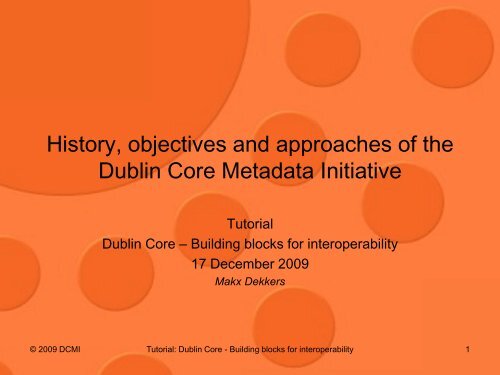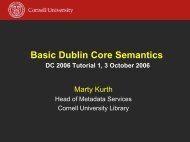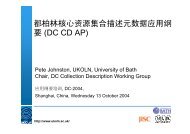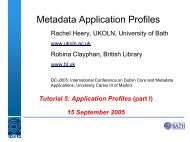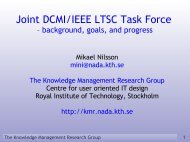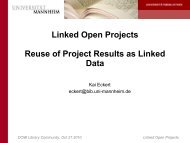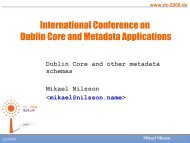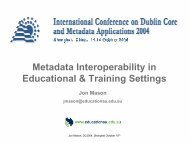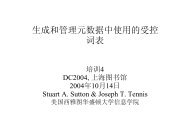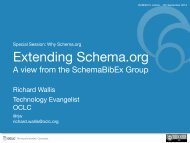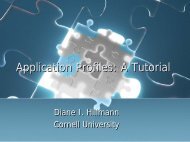History, objectives and approaches of the Dublin Core Metadata ...
History, objectives and approaches of the Dublin Core Metadata ...
History, objectives and approaches of the Dublin Core Metadata ...
Create successful ePaper yourself
Turn your PDF publications into a flip-book with our unique Google optimized e-Paper software.
“Legacy usage”‣ Initial 15 core elements are being used in HTML tags‣ Provides one modest level above HTML <strong>and</strong>UKOLN tags, <strong>and</strong> local XML elements like UK Office for Library Information Networkingor , adding st<strong>and</strong>ard meaning published <strong>and</strong>metadata062maintained http://www.bath.ac.uk/http://www.ukoln.ac.uk/2001-07-18‣“Flat” metadata model© 2009 DCMI Tutorial: <strong>Dublin</strong> <strong>Core</strong> - Building blocks for interoperability 9
Developments since 2000‣ Participating in <strong>the</strong> development <strong>of</strong> <strong>the</strong> “new Web”, <strong>the</strong> SemanticWeb <strong>and</strong> Linked Data‣ Approach partly based on early experience with <strong>Dublin</strong> <strong>Core</strong>• Eric Miller went from <strong>Dublin</strong> <strong>Core</strong> to W3C Semantic Web lead‣ Resource Description Framework based on <strong>the</strong> triple “statement”:• Subject – predicate – Object, or: Resource-A hasProperty B‣ <strong>Dublin</strong> <strong>Core</strong> is a core vocabulary for RDF predicates‣ Usage in many Semantic Web projects <strong>and</strong> products, <strong>and</strong> emergingusage as part <strong>of</strong> RDFa implementations‣ “Building block” metadata model© 2009 DCMI Tutorial: <strong>Dublin</strong> <strong>Core</strong> - Building blocks for interoperability 10
“Modern” <strong>Dublin</strong> <strong>Core</strong>‣ Initial <strong>Dublin</strong> <strong>Core</strong> (<strong>the</strong> dc: namespace) was intended foruse with simple strings as values:• 062• <strong>Metadata</strong>‣ Modern <strong>Dublin</strong> <strong>Core</strong> (<strong>the</strong> dcterms: namespace) definesdomains <strong>and</strong> ranges; e.g. <strong>the</strong> value <strong>of</strong> dcterms:subject is<strong>the</strong> concept not <strong>the</strong> string – could be a SKOS:Concept:• ‣ This usage is in line with Linked Data approach© 2009 DCMI Tutorial: <strong>Dublin</strong> <strong>Core</strong> - Building blocks for interoperability 11
“Packaging” metadata “records”‣ DC-based statements do not need to be in a “record”; <strong>the</strong>y canoccur <strong>and</strong> be exchanged individually (e.g. in RDFa)‣ DCMI Abstract Model describes how metadata statements can bepackaged into records or “descriptions” if needed• Basic building block: statement that says one thing about one resource• A description contains one or more statements about one <strong>and</strong> only oneresource (using DC <strong>and</strong> o<strong>the</strong>r vocabularies)• A description set may contain additional descriptions <strong>of</strong> relatedresources (e.g. whole/parts, photograph/photographer)‣ <strong>Dublin</strong> <strong>Core</strong> Application Pr<strong>of</strong>iles use Description Set Pr<strong>of</strong>iles toexpress rules <strong>and</strong> constraints on <strong>the</strong>se “records”© 2009 DCMI Tutorial: <strong>Dublin</strong> <strong>Core</strong> - Building blocks for interoperability 12
First steps‣ In October 1994, informal discussion at secondWWW Conference, Chicago‣ Identified a need for a “core” set <strong>of</strong> descriptors tohelp discover content on <strong>the</strong> Web‣ 1-3 March 1995, OCLC/NCSA workshop in<strong>Dublin</strong>, Ohio at OCLC Headquarters© 2009 DCMI Tutorial: <strong>Dublin</strong> <strong>Core</strong> - Building blocks for interoperability 14
<strong>Dublin</strong> <strong>Core</strong>: <strong>the</strong> original idea‣ A basic description mechanism for digitalinformation that:• can be used in all domains• can be used for any type <strong>of</strong> resource• is simple, yet powerful• can be extended <strong>and</strong> can work with specific solutions‣ Making it easier to find information on <strong>the</strong> Webas it develops (1995!)© 2009 DCMI Tutorial: <strong>Dublin</strong> <strong>Core</strong> - Building blocks for interoperability 15
Progress <strong>of</strong> <strong>Dublin</strong> <strong>Core</strong>‣ Participation from many sectors (libraries,research, governments, companies) <strong>and</strong> manycountries (more than 50)‣ Widely used‣ Since 1995, workshops <strong>and</strong> conferences inUSA, UK, Australia, Finl<strong>and</strong>, Germany, Japan,Italy, China, Spain, Mexico, Singapore, Korea© 2009 DCMI Tutorial: <strong>Dublin</strong> <strong>Core</strong> - Building blocks for interoperability 16
St<strong>and</strong>ardisation‣ 1998: <strong>Dublin</strong> <strong>Core</strong> Element Set version 1.0‣ 1998: Internet RFC2413‣ 1999: <strong>Dublin</strong> <strong>Core</strong> Element Set version 1.1‣ 2000: European Recommendation: CEN CWA 13874‣ 2001 (rev. 2007): US National St<strong>and</strong>ard: NISO Z39.85‣ 2003 (rev. 2009): International st<strong>and</strong>ard: ISO 15836‣ 2007: Internet RFC5013© 2009 DCMI Tutorial: <strong>Dublin</strong> <strong>Core</strong> - Building blocks for interoperability 17
DCMI Products‣ Documentation http://dublincore.org/specifications/• Semantic recommendations• User guidelines• Model-related specifications• Syntax guidelines‣ Community platforms http://dublincore.org/groups/‣ Annual conference http://dublincore.org/workshops/© 2009 DCMI Tutorial: <strong>Dublin</strong> <strong>Core</strong> - Building blocks for interoperability 18
DCMI Work structure‣ DCMI Communities• bringing toge<strong>the</strong>r people around specific topics or use<strong>of</strong> <strong>Dublin</strong> <strong>Core</strong> in a particular domain.‣ DCMI Task Groups• working towards a specific set <strong>of</strong> deliverables‣ DCMI Architecture Forum• providing a platform for technical discussions relatedto practical deployment (XML, RDF, (X)HTML)© 2009 DCMI Tutorial: <strong>Dublin</strong> <strong>Core</strong> - Building blocks for interoperability 19
DCMI Legal Structure‣ Not-for-pr<strong>of</strong>it “Company limited by Guarantee”incorporate in Singapore, December 2008‣ Hosted by <strong>the</strong> National Library Board Singapore‣ DCMI Board <strong>of</strong> Directors: legal signatories• Makx Dekkers, Raju Buddharaju‣ DCMI Executive: activity management• Makx Dekkers (CEO), Tom Baker (CIO)© 2009 DCMI Tutorial: <strong>Dublin</strong> <strong>Core</strong> - Building blocks for interoperability 20
DCMI Governance‣ DCMI Oversight Committee• organizational, financial, strategic oversight‣ DCMI Advisory Board• technical <strong>and</strong> strategic advice from communitymoderators, task group leaders, o<strong>the</strong>r experts‣ DCMI Usage Board• maintenance <strong>of</strong> <strong>the</strong> <strong>Dublin</strong> <strong>Core</strong> st<strong>and</strong>ards <strong>and</strong> review<strong>of</strong> community proposals© 2009 DCMI Tutorial: <strong>Dublin</strong> <strong>Core</strong> - Building blocks for interoperability 21
DCMI Organization Chart© 2009 DCMI Tutorial: <strong>Dublin</strong> <strong>Core</strong> - Building blocks for interoperability 22
DCMI supporters‣ DCMI Members:• National Library <strong>of</strong> Korea, National Library <strong>of</strong> Finl<strong>and</strong>,National Library Board Singapore, JISC (UK), Gov. OfNew Zeal<strong>and</strong>‣ DCMI Partners:• Infocom Corporation (Japan), FondazioneRinascimento Digitale (Italy)‣ Global community <strong>of</strong> experts <strong>and</strong> implementers© 2009 DCMI Tutorial: <strong>Dublin</strong> <strong>Core</strong> - Building blocks for interoperability 23
Highlights‣ <strong>Dublin</strong> <strong>Core</strong> development started by informalgroup <strong>of</strong> interested volunteers in 1995‣ From 1999, DCMI provided more formalstructures for cooperation, hosted by OCLC‣ Incorporated in Singapore, December 2008‣ Continuing to serve as an open platform for aglobal community <strong>of</strong> metadata experts <strong>and</strong> users© 2009 DCMI Tutorial: <strong>Dublin</strong> <strong>Core</strong> - Building blocks for interoperability 24


